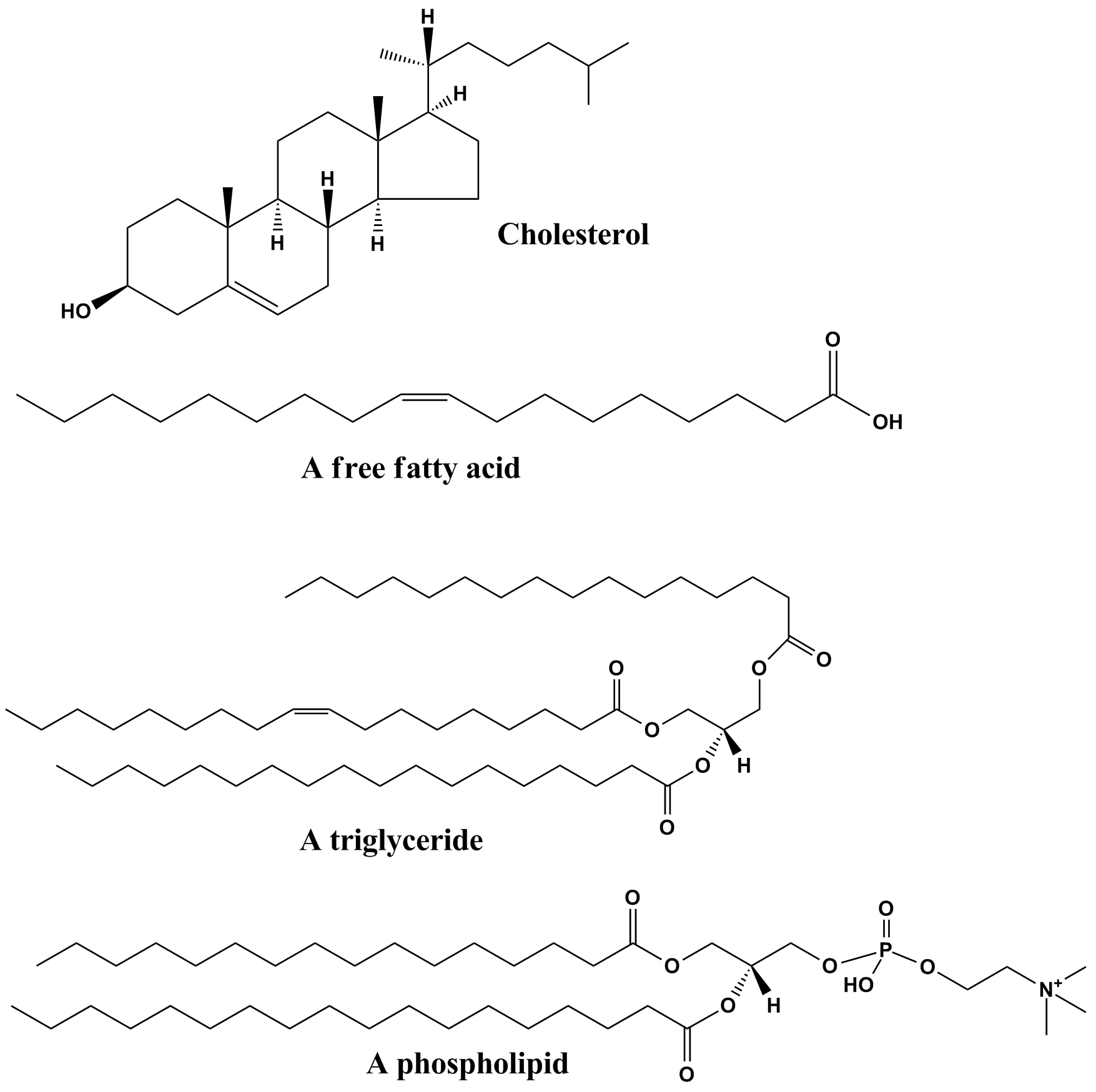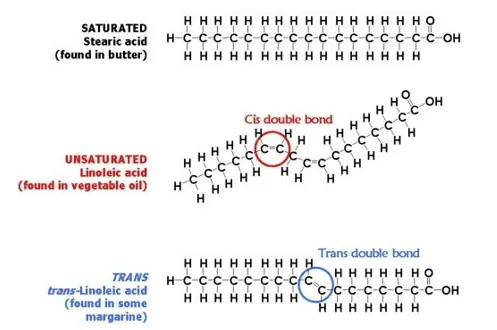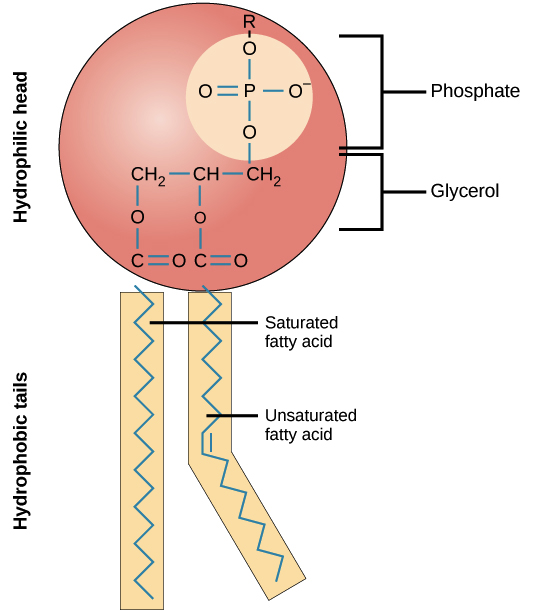1.4-1.6 Carbohydrates + Lipids + Nucleic Acids
Carbohydrates are organic compounds made up of carbon, hydrogen, and oxygen, typically in a ratio of 1:2:1. They can be classified into three main categories: monosaccharides, disaccharides, and polysaccharides. Monosaccharides, such as glucose and fructose, are the simplest forms of carbohydrates and serve as a primary source of energy for cells. Disaccharides, like sucrose and lactose, consist of two monosaccharides linked together, while polysaccharides, such as starch and glycogen, are made up of long chains of monosaccharides and play a role in energy storage.
used for structure and energy storage
C, 2H, O
Lipids are a diverse group of hydrophobic molecules, primarily composed of carbon and hydrogen, that serve various functions in biological systems, including energy storage, insulation, and forming cell membranes. They can be categorized into several types, including triglycerides, phospholipids, and steroids.
Hydrophobic is non-polar
hydrophilic is polar/charged
Triglycerides: Composed of glycerol and three fatty acids, they are the main form of stored energy in animals.
Phospholipids: Made of two fatty acids, a glycerol backbone, and a phosphate group, they play a crucial role in forming the bilayer of cell membranes.
Steroids: Characterized by a carbon skeleton consisting of four fused rings, they function as hormones and signaling molecules.
Structure of Lipids

Lipids are categorized into different types based on their structure and function, and they include:
Triglycerides: Composed of three fatty acids attached to a glycerol molecule, they are primarily used for energy storage and insulation.
Waxes: These are long-chain fatty acids linked to long-chain alcohols, providing protective coatings in plants and animals.
Saturated fatty acids: These contain no double bonds between carbon atoms, resulting in straight chains that can pack closely together, which typically makes them solid at room temperature (butter, tallow, coconut oil).
unsaturated fatty acids: These contain one or more double bonds between carbon atoms, resulting in kinks in the chains that prevent tight packing, which usually makes them liquid at room temperature (Olive oil).

Phospholipids: Composed of two fatty acids, a glycerol, and a phosphate group, these molecules are essential for forming cell membranes, providing the structural basis for the lipid bilayer that separates the interior of the cell from its environment.

Steroids: These are a class of lipids characterized by a carbon skeleton consisting of four fused rings, which play crucial roles in hormone regulation and cell membrane structure.
Cholesterol: A type of steroid, cholesterol is vital for maintaining cell membrane fluidity and is also a precursor for the synthesis of steroid hormones and bile acids.
Estradiol: A potent estrogen steroid hormone derived from cholesterol, estradiol is important for the regulation of the menstrual cycle and maintaining reproductive tissues.
Testosterone: Another significant steroid hormone, testosterone plays a key role in the development of male reproductive tissues, promotes secondary sexual characteristics, and is essential for overall male health.
Nucleic Acids: Composed of long chains of nucleotides, nucleic acids such as DNA and RNA are fundamental in the storage and transmission of genetic information, playing crucial roles in protein synthesis and the regulation of cellular activities.
Nucleotides are the building blocks of nucleic acids, consisting of a nitrogenous base, a five-carbon sugar, and one or more phosphate groups, each serving vital functions in cellular processes and heredity.
Nucleotides include adenine, thymine, cytosine, guanine, and uracil, which collectively contribute to the encoding of genetic information and the synthesis of essential proteins.
Polynucleotides are long chains formed by the linkage of nucleotides through phosphodiester bonds, resulting in the formation of RNA and DNA strands that enable the encoding of genetic information essential for life.
DNA: Deoxyribonucleic acid (DNA) serves as the primary repository of genetic information, composed of two strands that coil around each other to form a double helix structure, where sequences of nucleotides dictate hereditary traits and biological functions.
RNA (Ribonucleic Acid): Functions not only as a messenger in the protein synthesis process but also includes roles in the regulation and expression of genes. Additionally, RNA serves as a catalyst in certain biochemical reactions (ribozymes) and can be found in various types such as small interfering RNA (siRNA) and microRNA (miRNA), both of which play significant roles in gene silencing and post-transcriptional regulation.

DNA Nucleotides contain a deoxyribose sugar, a phosphate group, and one of four nitrogenous bases: adenine, cytosine, guanine, or thymine, which determine the specific portions of genetic information encoded within the DNA molecule.
RNA nucleotides contain a ribose sugar, a phosphate group, and one of four nitrogenous bases: adenine, cytosine, guanine, or uracil, which are crucial for forming RNA molecules that participate in various cellular functions such as translation and transcription.
Dehydration synthesis is a critical reaction that joins nucleotides together through the formation of phosphodiester bonds, resulting in a long chain of nucleic acids.
Differences between DNA and RNA are:
DNA is double-stranded, while RNA is single-stranded.
DNA contains thymine, whereas RNA contains uracil in place of thymine.
The sugar in DNA is deoxyribose, while RNA has ribose sugar.
DNA primarily serves as the genetic blueprint, whereas RNA is involved in protein synthesis and gene expression.
Types of RNA are:
Messenger RNA (mRNA): carries the genetic information from DNA to the ribosomes for protein synthesis.
Transfer RNA (tRNA): brings the appropriate amino acids to the ribosome during translation.
Ribosomal RNA (rRNA): a structural component of ribosomes, essential for protein synthesis.